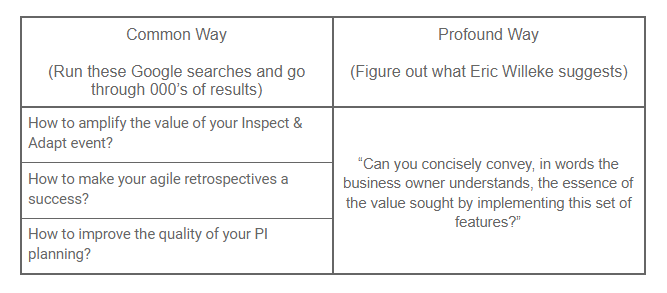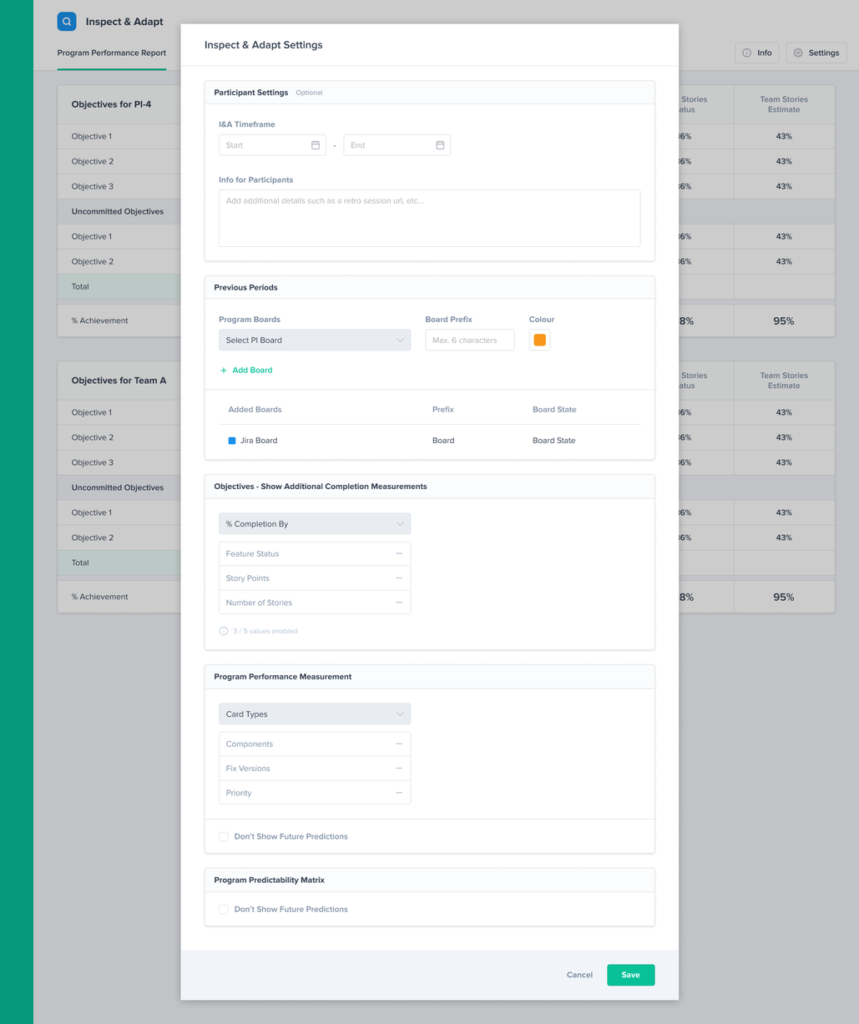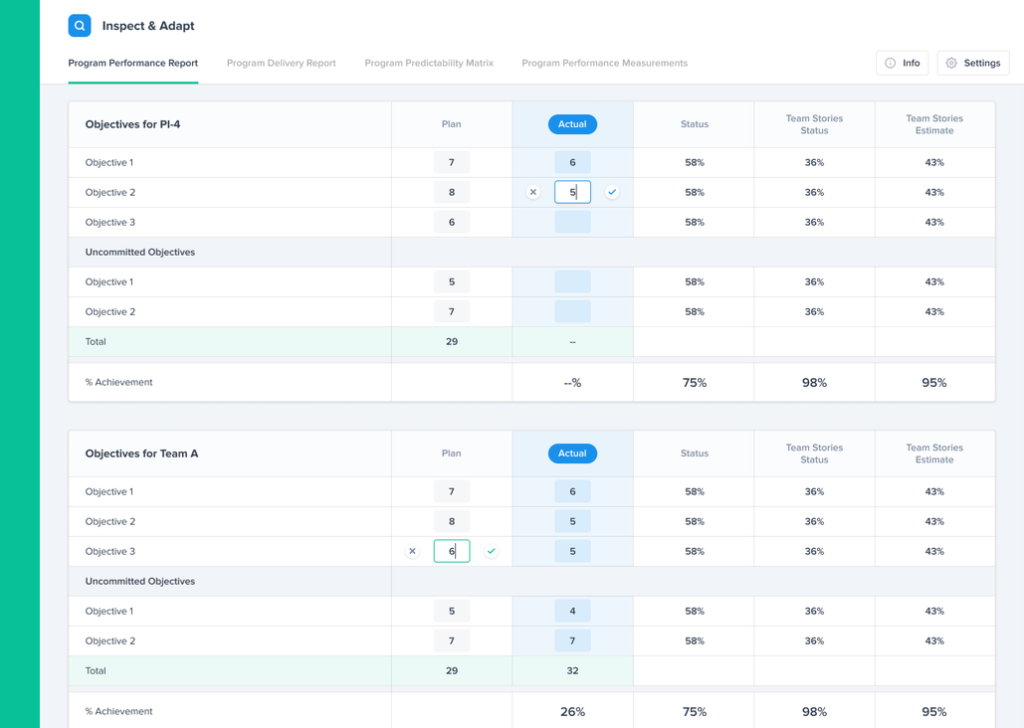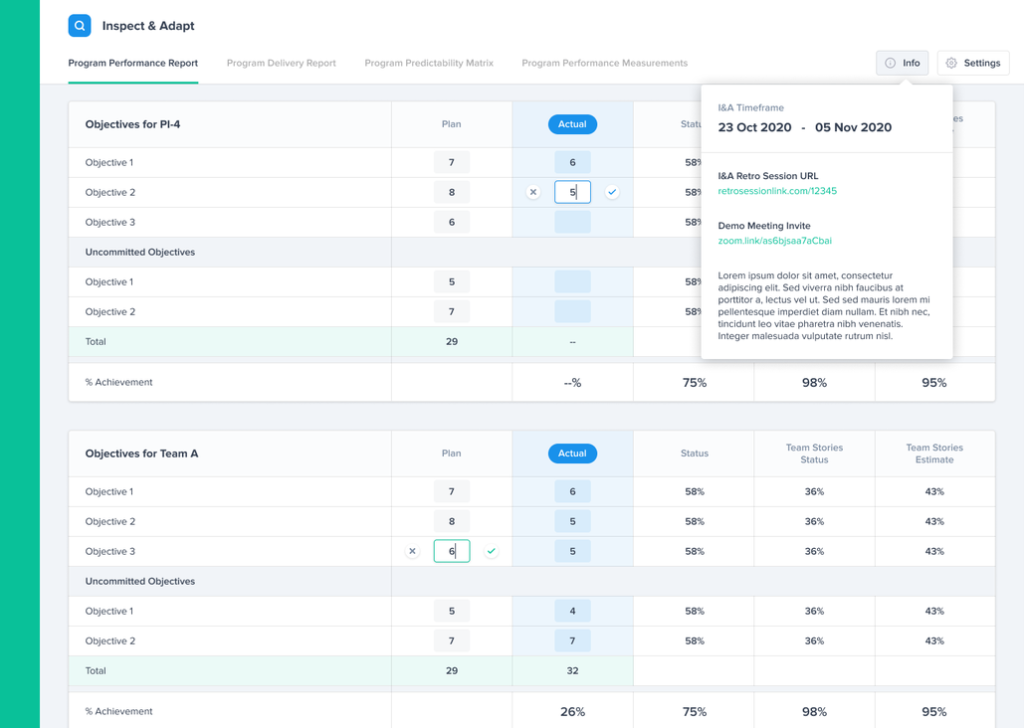“Any fool can know. The point is to understand.”
― Albert Einstein
Agile aligns development with business needs. According to the 14th Annual State of Agile Report, 54% of organizations consider business value as the top success metric for measuring Agile transformation.
This is why organizations working with SAFe understand the need for Iteration objectives to anchor the Value Stream to the business mission. Employing OKRs in SAFe adds more specificity to the connection between enterprise strategy and portfolio vision.
Two Is Better Than One
We have already talked about OKRs in depth here.
The scope of this post is to help you arrive at the vantage point from where the synergy between PI Objectives and Kendis’ Inspect & Adapt view makes itself apparent, and conveniently employable, for a rewarding and productive retrospective, which is the top Agile technique for 81% of practitioners.
So let’s begin.
If your product team takes its WHY from the OKRs, an effective PI planning ensures the successful HOW of it.

The three pillars of Scrum followed religiously in SAFe are transparency, inspection, and adaptation. Implemented via short, incremental sprints with their intrinsic adaptability to change, the process relies on the objectives to maintain a unified course of action despite the multiplicity of teams at distributed locations.
Objectives in SAFe have a business value and an actual value. In order to arrive at a wholesome way to evaluate and track the objectives, there seemed a need for a more quantifiable approach to measure progress and achievement.
Kendis responded to this Program Level management need by providing a 360 coverage of the objectives, linking objectives to features on your board. This enabled the teams to monitor in real-time, the progress of each objective while tracking the features and stories contributing to it.
To track progress, Kendis offers five options to calculate objectives completion percentage
- Linked Items Status
- Children of Linked Items (Stories) – Status: This is the default option
- Children of Linked Items (Stories) – Estimate
- Team Stories – Status
- Team Stories – Estimate
This is where objectives’ fully agilized potential is unleashed, benefitting both the development team and the business team alike. With Kendis’ capabilities, you find:
- Set objectives business value
- Link objectives to your features and stories
If new to Kendis, this guide to plan and track Objectives in SAFe can make your work a lot easier.

This solved a big business problem regarding tracking of PI objectives. However, one challenge still remained, which appeared at the stage of accountability represented by the Inspect & Adapt event in SAFe and haunted the facilitators.
CHALLENGE
No great legend is ever complete without a tough challenge.
This is no different.
One of the biggest challenges a product team in a large organization faces on a recurrent basis, is neither financial, nor structural in nature. Hard to address, and harder to identify, it is the absence of a common language for communicating with optimal efficacy the business and technology issues alike, to the stakeholders. This gradually grows into a disconnect eventually leading to a compromised quality of the Inspect & Adapt event and absent actionable insights. The limitation of a timeboxed retrospective only compounds the gravity of this disconnect.
This is such a common occurrence that most PMs take it as part of the SAFe framework. Nothing, in fact, is farther from truth.
If your Demo has been successful in presenting a functional PI, the next stop is meeting this challenge.
It could be represented in two ways.

The answer is: STATS.
Put everything out there from the tiniest to the mightiest, in the universal language of truth.
Numbers is the language that ensures the clarity of communication as required by OKRs, and the transparency as demanded by SAFe. It is also the only language that conveys the same message without leaving out anything open to interpretation. Using stats there can be nothing lost in translation.
The goal of the retrospective at the end of any PI is to be able to identify a few significant problems which the teams can potentially address.
However, inside an Inspect & Adapt event, the activities are so tightly packed that the Retrospective is transformed into an exhaustive chore list even for the best of the RTEs or experienced facilitators. This is typically because there is a lot to coordinate and you would need to look in several locations to establish what occured for the content of the Program Increment as well as the teams.
As a result, the entire Retrospective effectively becomes an exercise in sharing the individual perceptions of the ART. With multiple teams having their own agendas as well as their own knowledge of the work they are carrying out, and a variety of functional approaches towards issues, the quality of the diagnostic process offered by a good Retrospective gets muddled.
This affects the Problem-solving process and adversely impacts the root-cause analysis, thereby, denting the desired quality of a good Retrospective and consequently the next PI planning.
Kendis’s new Inspect & Adapt view addresses this challenge.
THE EMERALD TABLET: Kendis I&A View
“If I had an hour to solve a problem I’d spend 55 minutes thinking about the problem and 5 minutes thinking about solutions.”
― Albert Einstein
With its Inspect & Adapt view release, Kendis has facilitated the Product Owners, Product Managers, Scrum Masters, RTEs, and all the Retrospective facilitators with the proverbial Emerald Tablet.
Irrespective of the limitations imposed by a tight schedule, and multiplicity of languages, cultures, structures and issues, all the stakeholders get the actual picture of the ART without anything lost in the translation.
If Einstein required 55 minutes thinking about the problem, collating all the necessary data, and spared only 0.083 percent of the total time for finding solutions, Kendis facilitates you with a single click to find all Objectives progress information at your screen, displaying all the weak areas so that you and your team, along with all the stakeholders avail the 100 percent for your time in the problem solving workshop for a productive and honest root cause analysis.
This ease of objectives tracking at the Inspect & Adapt event is a unique Kendis offering at the Program as well as Solution level.
The Program Performance Report at the Inspect & Adapt view offers a complete breakdown of the individual team’s progress with their objectives, along with the sum of their contributions in the PI. As can be seen, against each objective of an individual team as well as the Product PI, Kendis provides you with all the relevant scores documenting the business value (planned and actual), status, team stories estimate, and team stories status.
Employing the desired I&A timeframe, you can apply filters to the PI duration you wish to evaluate, thereby timelocking the period under consideration.
Not only this, the I&A Program Performance Report at Kendis allows you to set parameters at the dashboard level to enable a direct comparison of your current PI objectives against any previous PI objectives. Say goodbye to hunching over data plotting graphs and scaling data.

While the PI objectives part gets covered here, the Inspect & Adapt view at Kendis goes further.
Other functionalities that Kendis’ Inspect & Adapt view provides are:
- I&A Program Delivery report
- I&A Program Predictability Matrix
- I&A Program Performance Measurements
Now your I&A event is facilitated with data that is cleaner, stronger, and more convenient than ever, presenting the complete picture of your PI in a common language.

The candidness of the status and score of the Iteration goals together with personable, and most significantly, actionable quantitative performance metrics at Kendis I&A view facilitates your Retrospective with a degree of honest reflective wholesome quality you never thought could be achievable in a large scale Inspect & Adapt event. It is the quality that manifests understanding and meeting the purpose of a sound Inspect and Adapt event.
Because, the point is to not just know, but understand.











